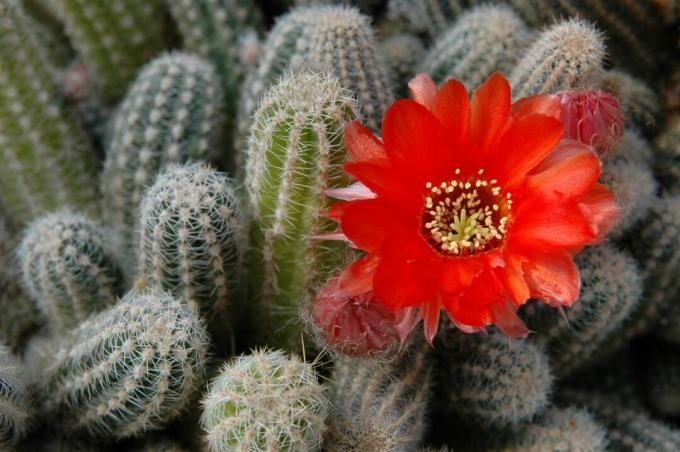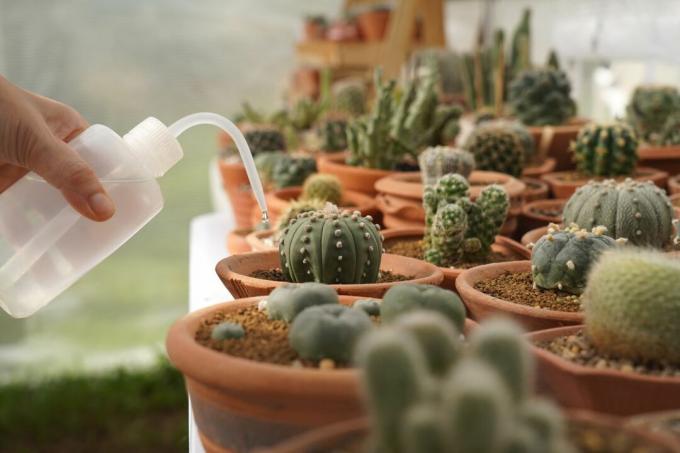Cacti (Cactaceae) are very popular ornamental plants. We give expert tips on what you need to consider when caring for and fertilizing the prickly plants.

Cacti (Cactacea) are a family within the order of the carnation-like (Caryophyllales) and belong to the Bedecktsamern (Magnoliopsida). In general, more than 100 genera and over 1500 species belong to the cactus family. These numbers alone suggest that cacti are significantly more diverse in terms of their morphology and physiology than one might initially assume. There are tree-like species such as Pereskia grandifolia, but also very tiny species like Blossfeldia liliputana. What they have in common, however, is that they are all based on the American continent. Here their occurrence extends from southern Canada to Argentina and Chile. They colonize different habitats from tropical rainforests to arid deserts. What these very different habitats have in common: Seasonal water availability.
contents
-
Water cacti properly
- Water indoor cacti
- Watering cacti in the garden
-
Fertilize cacti properly
- Fertilize indoor cacti
- Fertilize cacti in the garden

Cacti belong to the group of succulents. They can store moisture in their tissues and survive even when it is very dry. In addition, the thorns minimize water evaporation and also protect against predators. Just as they can endure exhausting heat, hardy cacti also survive temperatures as low as an almost unbelievable -20 ° C. The hardy species include, among others Chamaecereus silvestrii and Cylindropuntia imbricata. Not least because of these properties, cacti are considered the Spartans among the ornamental plants. Put in the sun, some water and nothing more can happen. But there are also a few points to consider when caring for cacti. Although the requirements vary between the species, there are some tips and tricks for fertilizing and watering Basically to be observed, so that the small green cactus on the balcony also becomes a really big one can.

Water cacti properly
Cacti regularly need water, especially during the growth and flowering period in spring and summer. However, you should not water too often and avoid waterlogging, as otherwise there is an increased risk of rot. The substrate should (almost) completely dry out before watering again.
Water indoor cacti
In the case of indoor cacti, growth can be stimulated in spring by showering over them. About a week later, the water is more vigorous. As a rule of thumb, you should water thoroughly during the growing season from March to September. This can easily be checked by potting. You only pour again when the substrate is completely dry. Coasters, bowls or planters can absorb excess water or be used for watering from below. Another tried and tested method is the damming method: Here you put the pot with the cactus in a larger container with water so that the pot is completely submerged. As soon as no more air bubbles rise, take the cactus out of the water and, after it has drained well, put it back in its place.
Watering cacti in the garden
If the cacti are in the garden, then it is advisable to ensure sufficient water supply, especially in the spring months. You should water fairly regularly in summer. But only on sunny days or after longer periods of drought in order to avoid overwatering due to subsequent rain. At the change of the season, the pouring rhythm is then gradually reduced. Particular attention should be paid to watering in winter. On the one hand, there is an increased risk of the soil becoming wet and fungal infections spreading. An additional rain cover should therefore be set up. On the other hand, a dry period in the winter months encourages many cactus species to flower in the following year. However, this can only be implemented with potted plants that overwinter under cover.
Fertilize cacti properly
It is a common misconception that cacti don't need fertilization. On the contrary, there are few plants that are as dependent on fertilization as cacti. Deficiency symptoms often appear late and can then no longer be remedied quickly. Fertilizing in good time is therefore essential in order to be able to enjoy the plants for a long time.

Fertilize indoor cacti
For indoor cacti you should use approx. four to six weeks after the first shower in the spring start fertilizing with a normal full fertilizer dissolved in water. A liquid fertilizer like ours Plantura organic indoor & green plant fertilizer can be given every second watering from spring to July. However, the dosage for cacti is reduced to just 1 ml per liter of irrigation water.
Fertilize cacti in the garden
Outside, coarse horn shavings can be added to the soil in the garden or to the substrate in the planter as a basic fertilization. Nevertheless, you should also fertilize from March. In the months of April to June a 14-day fertilization has proven itself. You can use between 20 and 30 grams of a complete fertilizer per square meter (e.g. B. Blue grain). The liquid fertilizers available on the market (usually: 1% nutrient solution) should be watered regularly. In July it is advisable to only lightly fertilize the plants. It is also advantageous to add a potassium fertilizer (potassium magnesia 20 g / m2) admit. As a result, the plants harden well and are well prepared for the coming winter.
If you want to know more about caring for your plants, you will find it here 5 best tips for caring for cacti and succulents.
